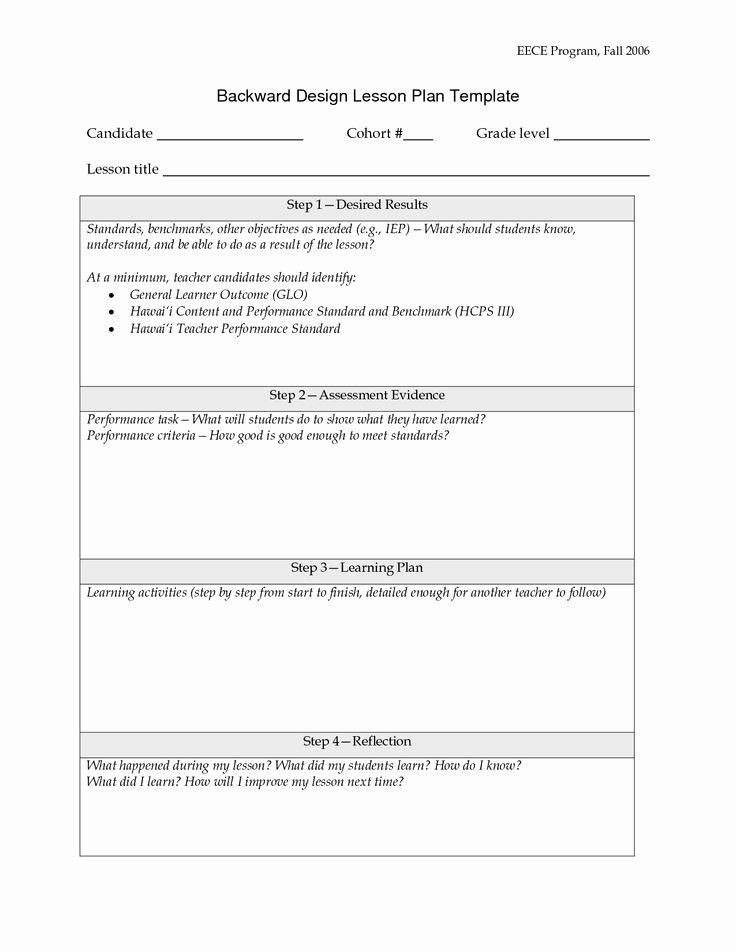Table Of Content
- Stage 3: Plan Learning Activities and Instructional Materials
- Developing a backward design lesson plan step by step
- responses to “World Language Lesson Planning with Backwards Design”
- Student-centered
- Backwards Design Step Three: Learning Strategies / Activities
- In Corporate Training and Adult Education
- The 9 best gifts for content creators in 2023

Contrary to a popular assumption, this does not mean that the leaning goal has to be quantitatively measured by some objective instrument (like a multiple-choice test). Valid and accepted measurements will vary from discipline to discipline and include both quantitative and qualitative measures. As the course designer, you decide what kind of measurements will work best for your subject. The important thing is that there is some way to identify whether or not learning outcomes are being met.
Stage 3: Plan Learning Activities and Instructional Materials
Backward designing an online course leads you to be more intentional about your use of the online space, helping to mitigate the challenges of online learning while maximizing its affordances. You will follow the same step-by-step process above, but there are a few additional elements to consider during Steps 3-5. In no time at all, you might see improvements in the performance of your students, the quality of your classes, and the ratings of your online lessons. This is the same philosophy that follows many standardized tests in public schools around the country. Public school teachers will often “teach the test” by focusing primarily on what will be on federal or state standardized tests instead of other content or modules in textbooks. In that case, make sure that you give your students plenty of time to write notes for your lessons so they can study them and answer you promptly and accurately come test day.
Developing a backward design lesson plan step by step
Some lessons might need a slight tweak here or there and others might be best to leave out altogether. Remember, just let your learning goal and pre-planned assessment be your guide. Whatever the case may be, there is an alternative approach that helps instructors avoid these pitfalls and mitigate student frustrations with their learning experiences.
responses to “World Language Lesson Planning with Backwards Design”
In other words, they don’t see an alignment between what they learned and what they were tested on. Complete the Backwards Design Lesson Planning Template to walk through the three stages of the backwards design planning process to plan an upcoming lesson. This should be a lesson that you can implement within the next couple of weeks so that you are able to see the impact this planning process has on student performance. You may want to refer to the Backwards Design Lesson Planning Template SAMPLE as a guide.
These clearly articulated end-goals mean it is significantly easier to see where a learning activity may have derailed and then how to fix it. It also reduces my time at the podium and reminds students that their ability to understand, contextualize, explain, and apply content is the true goal of their education. As teachers, you want students to learn skills that can equate to great academic results, but that can also be applied in later life. This means that as teachers, we need to focus on content but also on its practical application.
Every task and piece of instruction has a purpose that fits in with the overarching goals and goals of the course. Students will also need support to know how to prepare for assignments, to evaluate their work, and to understand their performance. Consider how your teaching strategies and learning activities will explicitly prepare students for assignments and how you can provide tangible feedback on their progress. So far you have defined your course learning goals and outcomes and planned your assessments of student learning. In Step 4, you will choose the course content that will support students to succeed on those assessments.
Since the point of defining ILOs is to provide a design focus for your course and to clarify goals for students, specificity is very important. In your statement of your learning outcomes, it should be clear exactly what the goal is. In particular, beware of words like “understand” or “know.” Exactly what it means to “understand” or “know” something is open to interpretation. An undergraduate’s level of “understanding” of a topic and that of the instructor will vary wildly, and it will be difficult for students to know which level of understanding they should be aiming for. When developing ILOs, ask yourself how you will know that a student “understands” the material – what will they need to do, or say to demonstrate their understanding?
Once the learning goals have been established, the second stage involves consideration of assessment. The backward design framework suggests that instructors should consider these overarching learning goals and how students will be assessed prior to consideration of how to teach the content. For this reason, backward design is considered a much more intentional approach to course design than traditional methods of design. Rather than starting with decisions about course content, the backward design process begins by asking you to determine what you want students to learn. Assignments are then developed, with the aim of allowing students to practice and demonstrate that learning.
The 9 best gifts for content creators in 2023
Maria Vera-Drucker: How to STEM-ify Your School - Innovation & Tech Today
Maria Vera-Drucker: How to STEM-ify Your School.
Posted: Wed, 15 Feb 2017 14:56:16 GMT [source]
The first and most important problem is a lack of durable, transferable learning. One reason so many of us don’t remember much of what we learned in school is that we learned it through this haphazard, topic-driven approach. These random activities are taking up precious time that could be spent on much more valuable stuff. Ohio State historyLong before Wiggins and McTighe popularized backward design, Ralph Tyler was working with fellow faculty at The Ohio State University to improve data gathered from assessments. As early as his 1934 article, “Some Findings from Studies in the Field of College Biology,” Tyler details how he helped faculty sketch out the ideas of needs analysis, backward design, and setting behavioral objectives. In Understanding by Design, Wiggins and McTighe reference Tyler as the originator of behavioral objectives (2005, p. 20).
When teachers use Backward Design, they can consult Bloom's Taxonomy to identify the level of cognitive skills they wish students to attain. Whether the goal is simply to remember dates or analyze historical events, Backward Design helps educators map out a targeted learning path to achieve the desired complexity level. In other words, a superior education will teach students to think and practice like scientists.
Even if we do follow the book exactly the way it was written, we can be under the illusion that our students are actually understanding what’s going on until it’s time to complete an exit ticket. Some books may introduce the concept of a number bond and call it a “math mountain” or they may call it decomposing. Some books don’t use model drawings and have children do a quick draw (which is not as universally applicable).

Backward Design is a teaching method that involves designing educational curriculum by setting goals before choosing instructional methods and forms of assessment. This teaching model lends itself very well to proficiency-based language teaching as it requires the teacher to focus on what students will ultimately be able to do with the language, rather than simply knowing about the language. The process is logical – if teachers focus on the desired learning then the appropriate teaching methods will follow. With backwards design, teachers shift their thinking from a content-focused design to a result-focused approach. In this way, the integration of different subject matter and the use of technology becomes organic in the design of the unit.
The first question listed above has instructors consider the knowledge that is worth being familiar with which is the largest circle, meaning it entails the most information. The second question above allows the instructor to focus on more important knowledge, the knowledge and skills that are important to know and do. Finally, with the third question, instructors begin to detail the enduring understandings, overarching learning goals, and big ideas that students should retain. By answering the three questions presented at this stage, instructors will be able to determine the best content for the course. Traditional lesson planning starts with choosing a topic (and often a book title) to teach. From there, the teacher plans out a series of lessons and activities to teach student content that falls under the umbrella of the chosen topic.
In contrast, the 3 general ILOs help students understand the course’s scope and aim in a more digestible way. Notice that a general learning outcome (“tease out the laws of electromagnetism…”) is rather non-specific. One of the most frequently cited challenges of Backward Design is the time commitment required for planning. Educators like Linda Darling-Hammond have noted that preparing comprehensive plans and aligning them with assessments and activities can take substantial time.

Now it’s time to create lessons and activities for your course materials. Since you already know what your tests will be about, this should be relatively easy. Jean Pak is the founder and owner of Jean Pak LLC and a Thinkific Expert and Learning Experience Designer helping businesses develop more interactive and engaging learning experiences.
Current trends in educational technology, personalized learning, and inclusive education all offer exciting avenues for integrating and evolving the principles of Backward Design. Scholars in the field of special education, such as Thomas Hehir, question whether the Backward Design framework is flexible enough to accommodate learners with diverse needs. Issues around accessibility, differentiated instruction, and cultural responsiveness come to the fore. According to these critics, the structured, step-by-step nature of Backward Design could potentially stifle spontaneity and limit opportunities for exploratory learning. This could be particularly problematic in subjects like the arts, where creative exploration is key. Educational scholars like Alfie Kohn have raised concerns that an approach like Backward Design, which starts with outcomes and assessments, might place too much emphasis on testing and grading.

No comments:
Post a Comment